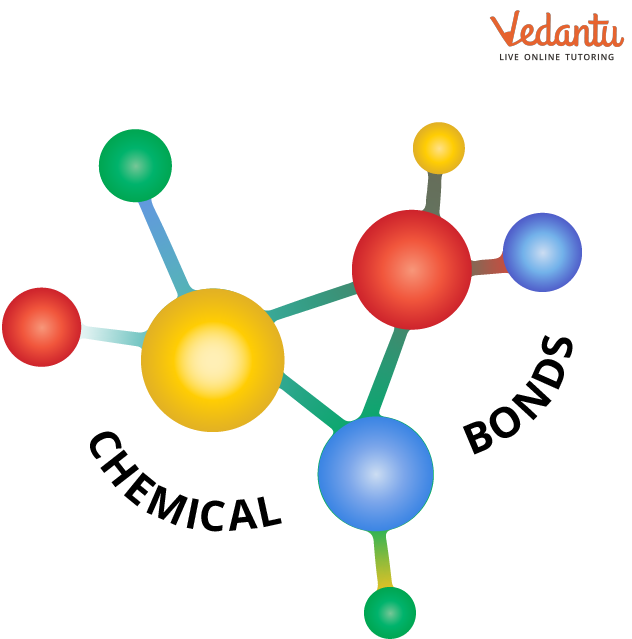




Introduction
You already know that all types of matter are made up of atoms, which explains the chemical bond definition. Everything around you is made up of atoms, including the food you eat, the water you drink, the pets, toys, and even your own body. Since there are such strong attraction forces between the atoms, these atoms naturally interact with other atoms via chemical bonds.
These atoms are so small that you need a microscope to see them. How can something so small as an atom help us? Like Lego blocks, these tiny atoms become useful when they join together. Now let us learn in detail about the chemical bond.

Chemical Bond
What is Chemical Bond?
The chemical bond definition: Chemical bonding is when two or more molecules, atoms, or ions come together to form a chemical compound. The atoms that make up the complex are held together by chemical bonds.
Atoms receive or lose electrons or trade them with other atoms to achieve a stable electronic configuration. As a result, the system's energy level drops to its lowest point and a chemical bond forms. Maximum stability is achieved in this way. A covalent bond forms when two atoms share electrons, whereas an ionic bond forms when one or both atoms lose or acquire an electron.
Types of Chemical Bonds
There are two different kinds of chemical bonds that can happen. Covalent bonds and ionic bonds are the names of these two types of bonds. Each of these types of bonding uses electrons in a different way to make sure that each atom has a full outer shell.
Covalent Bonding - Electrons are always shared between two atoms in pairs. Neither atom loses or gains an electron during this type of bonding. Instead, they share their electrons so that their outer shells are full.
Ionic Bonding - When atoms of one element give their electrons to atoms of another element so that both can have a full outer shell, this is called an ionic bond.
Chemical Bond With Examples

Understand the Chemical Bond Meaning with Chemical Bond Images
Below mentioned are the chemical bond examples: -
Let's look at some elements, like sodium and fluorine, to get a better idea of how chemical bonds work.
The outer shell of sodium (Na) only has one electron. Now, this sodium atom can do one of two things. It can give one of the electrons in its third shell to another atom and have two complete shells with 8 electrons in each orbit, or it can keep looking for a kind atom with extra electrons to meet it someday and fill up its third shell. Which one seems simpler to you? It has to be the first one! It is much easier for the atoms to give away their electrons than to keep waiting to get more.
The outer shell of the atom of another element, fluorine (F), has 7 electrons, so it is missing one electron to be "happy." So, these two atoms make themselves happy by giving and taking electrons from their outer shells. In other words, the sodium atom provides the fluorine with an extra electron in its outer shell.
After this, both atoms have 8 electrons in their outer shells. An ionic bond is a name for this type of bond. When an atom loses an electron, it gets a positive charge like sodium (Na+), and when it gains an electron, it receives a negative charge like fluorine (F-). Positive and negative charges attract each other like magnets, and this helps the bond form and stay together. These all can be easily findable in the chemical bonding worksheet.
Chemical Bonding Worksheet
The list of compounds with their chemical bonding between atoms of these compounds for 15 compounds are as follows:
Interesting Facts About Chemical Bonds
Facts that are interesting regarding chemical bonds:
Since noble gases have a naturally full shell, they rarely react.
Most of the time, ionic bonds are made between metals on the left side of the periodic table.
Atoms in molecules stick together because the nucleus and the electrons attract each other.
Summary
A chemical bond is a way for atoms, ions, or molecules to always pull toward each other. As in ionic compounds, bonding can happen when two ions with different charges are drawn to each other or when two atoms share electrons, as in covalent bonds. The strength of the chemical bonds is very different from one to the next. A "chemical bond" is the place where two atoms stick together.
FAQs on Facts About Chemical Bonds Explained in Detail
1. Why is a chemical bond important?
Chemical bonds are essential because they keep molecules and atoms next to each other. There are chemical bonds between atoms in every single molecule.
Moreover, there are chemical bonds between particles of every single thing. Atoms and molecules have different kinds of forces that hold them together.
2. What is the length of chemical bonds?
When bond lengths are compared, it may be possible to see the predicted trend that bonds between bigger atoms are longer and bonds between smaller bits are shorter.
It's surprising to learn that the strength of a relationship and the length of the connection are linked in the wrong way. In general, a short connection is stronger than a longer bond length.
3. What does it mean by ionic bonding?
Ionic bonds are ions with opposite charges held together by electrostatic forces in atoms. So, the molecule's ionic bonds are made when an electron or electrons move from an electropositive metal atom to an electronegative non-metal atom.









